Estimating Radiation Shielding of Fired Clay Bricks Using ANN and GEP Approaches
Abstract
:1. Introduction
2. Methodology
2.1. Specimen Description
2.2. Specimen Preparation
2.3. Test Conducted on Brick Specimens
2.3.1. Density Determination
2.3.2. Compressive Strength Test
2.3.3. Radiation Testing of Bricks
- Measuring of Gamma ray intensity (No) by the detector when no brick specimens were placed between the source and detector.
- Measuring of Gamma ray intensity (N) by the detector when brick specimens were placed between the source and detector.
- μ = Linear attenuation coefficient
- x = material thickness in cm
2.4. Algorithms Adopted for the Development of AI Models
2.4.1. Artificial Neutral Network Modelling
2.4.2. GEP Modelling
3. Results and Discussion
3.1. Experimental Results
3.2. Performance Evaluation of AI Models
3.3. Parametric Analysis
4. Conclusions
- The two key elements that reduce the amount of gamma radiation are material density and brick thickness. The brick’s capacity to block radiation is enhanced by increasing its thickness and density. Among the investigated additives, it was observed that the addition of iron slag significantly increased the density, thus leading to improved resistance against radiation. The maximum radiation shielding was observed at 25% replacement of clay by iron slag. It was discovered that a rise in the compressive strength also improved the radiation capability of the bricks.
- The addition of fly ash and wood ash considerably decreased the density and compressive strength of modified clay bricks compared to the conventional bricks. The worst radiation capability of clay bricks was obtained at the maximum replacement of fly ash and wood ash investigated in the study.
- The AI models created for this study closely matched the outcomes of the experiments and the predictions. The ANN model that was created to forecast radiation shielding surpassed the GEP model. However, the GEP model’s importance may be seen in the straightforward mathematical relationship it generated since it can be used in the future to forecast how radiation shielding will affect fresh data without the use of a computer program.
- The results of the parametric analysis agreed with those of the experiment. The most important factors affecting the shielding capacity of concrete were discovered to be the thickness and density of clay bricks.
Author Contributions
Funding
Institutional Review Board Statement
Informed Consent Statement
Data Availability Statement
Acknowledgments
Conflicts of Interest
Appendix A. The Code Developed for the ANN Model
- x = ‘inputs’;
- t = ‘RS’;
- % Choose a training function
- % For a list of all training functions type: help nntrain
- % ‘trainlm’ is usually fastest.
- % ‘trainbr’ takes longer but may be better for challenging problems.
- % ‘trainscg’ uses less memory. Suitable in low memory situations.
- trainFcn = ‘trainlm’; % Levenberg–Marquardt backpropagation.
- % Create a fitting network
- hiddenLayerSize = 10;
- net = fitnet(hiddenLayerSize,trainFcn);
- % Setup division of data for training, validation, testing
- net.divideParam.trainRatio = 70/100;
- net.divideParam.valRatio = 30/100;
- % Train the network
- [net,tr] = train(net,x,t);
- % Test the network
- y = net(x);
- e = gsubtract(t,y);
- performance = perform(net,t,y)
- % View the network
- view(net)
- % Plots
- % Uncomment these lines to enable various plots.
- %figure, plotperform(tr)
- %figure, plottrainstate(tr)
- %figure, ploterrhist(e)
- %figure, plotregression(t,y)
- %figure, plotfit(net,x,t)
References
- Du, W.; Zhang, L.; Li, X.; Ling, G.; Zhang, P. Nuclear Targeting Subcellular-delivery Nanosystems for Precise Cancer Treatment. Int. J. Pharm. 2022, 619, 121735. [Google Scholar] [CrossRef] [PubMed]
- Tanaka, S.; Hosokawa, M.; Tatsumi, A.; Asaumi, S.; Imai, R.; Ogawara, K.-I. Improvement of resistance to oxaliplatin by vorinostat in human colorectal cancer cells through inhibition of Nrf2 nuclear translocation. Biochem. Biophys. Res. Commun. 2022, 607, 9–14. [Google Scholar] [CrossRef] [PubMed]
- Pinsky, R.; Sabharwall, P.; Hartvigsen, J.; O’Brien, J. Comparative review of hydrogen production technologies for nuclear hybrid energy systems. Prog. Nucl. Energy 2020, 123, 103317. [Google Scholar] [CrossRef]
- Parker, H.M.O.; Joyce, M.J. The use of ionising radiation to image nuclear fuel: A review. Prog. Nucl. Energy 2015, 85, 297–318. [Google Scholar] [CrossRef]
- Christodouleas, J.P.; Forrest, R.D.; Ainsley, C.G.; Tochner, Z.; Hahn, S.M.; Glatstein, E. Short-Term and Long-Term Health Risks of Nuclear-Power-Plant Accidents. N. Engl. J. Med. 2011, 364, 2334–2341. [Google Scholar] [CrossRef]
- Brook, B.W.; Alonso, A.; Meneley, D.A.; Misak, J.; Blees, T.; van Erp, J.B. Why nuclear energy is sustainable and has to be part of the energy mix. Sustain. Mater. Technol. 2014, 1, 8–16. [Google Scholar] [CrossRef]
- Marcone, M.F.; Wang, S.; Albabish, W.; Nie, S.; Somnarain, D.; Hill, A. Diverse food-based applications of nuclear magnetic resonance (NMR) technology. Food Res. Int. 2013, 51, 729–747. [Google Scholar] [CrossRef]
- Taylor, R.E.; Bar-Yosef, O. Radiocarbon Dating: An Archaeological Perspective; Routledge: Hoboken, NJ, USA, 2016. [Google Scholar]
- Tyagi, G.; Singhal, A.; Routroy, S.; Bhunia, D.; Lahoti, M. Radiation Shielding Concrete with alternate constituents: An approach to address multiple hazards. J. Hazard. Mater. 2020, 404, 124201. [Google Scholar] [CrossRef]
- Sadiq, M.; Wen, F.; Dagestani, A.A. Environmental footprint impacts of nuclear energy consumption: The role of environmental technology and globalization in ten largest ecological footprint countries. Nucl. Eng. Technol. 2022. [Google Scholar] [CrossRef]
- Golden, A.P.; Cohen, S.S.; Chen, H.; Ellis, E.D.; Boice, J.D., Jr. Evaluation of statistical modeling approaches for epidemiologic studies of low-dose radiation health effects. Int. J. Radiat. Biol. 2022, 98, 572–579. [Google Scholar] [CrossRef]
- Hasegawa, A.; Tanigawa, K.; Ohtsuru, A.; Yabe, H.; Maeda, M.; Shigemura, J.; Ohira, T.; Tominaga, T.; Akashi, M.; Hirohashi, N.; et al. Health effects of radiation and other health problems in the aftermath of nuclear accidents, with an emphasis on Fukushima. Lancet 2015, 386, 479–488. [Google Scholar] [CrossRef]
- Desouky, O.; Ding, N.; Zhou, G. Targeted and non-targeted effects of ionizing radiation. J. Radiat. Res. Appl. Sci. 2015, 8, 247–254. [Google Scholar] [CrossRef]
- Akkurt, I.; Akyildirim, H.; Mavi, B.; Kilincarslan, S.; Basyigit, C. Gamma-ray shielding properties of concrete including barite at different energies. Prog. Nucl. Energy 2010, 52, 620–623. [Google Scholar] [CrossRef]
- Ahmad, I.; Shahzada, K.; Ahmad, M.I.; Khan, F.; Badrashi, Y.I.; Khan, S.W.; Muhammad, N.; Ahmad, H. Densification of Concrete using Barite as Fine Aggregate and its Effect on Concrete Mechanical and Radiation Shielding Properties. J. Eng. Res. 2019, 7, 81–95. [Google Scholar]
- Maslehuddin, M.; Naqvi, A.; Ibrahim, M.; Kalakada, Z. Radiation shielding properties of concrete with electric arc furnace slag aggregates and steel shots. Ann. Nucl. Energy 2013, 53, 192–196. [Google Scholar] [CrossRef]
- González-Ortega, M.; Cavalaro, S.H.P.; Aguado, A. Influence of barite aggregate friability on mixing process and mechanical properties of concrete. Constr. Build. Mater. 2014, 74, 169–175. [Google Scholar] [CrossRef]
- Saidani, K.; Ajam, L.; Ben Ouezdou, M. Barite powder as sand substitution in concrete: Effect on some mechanical properties. Constr. Build. Mater. 2015, 95, 287–295. [Google Scholar] [CrossRef]
- Osman, G.; Witold, B.; Cengiz, O.; Muuml, F. An investigation on the concrete properties containing colemanite. Int. J. Phys. Sci. 2010, 5, 216–225. [Google Scholar]
- Lv, Y.; Qin, Y.; Wang, J.; Li, G.; Zhang, P.; Liao, D.; Xi, Z.; Yang, L. Effect of incorporating hematite on the properties of ultra-high performance concrete including nuclear radiation resistance. Constr. Build. Mater. 2022, 327, 126950. [Google Scholar] [CrossRef]
- Ibrahim, A.M.; Mohamed, A.R.; El-Khatib, A.M.; Alabsy, M.T.; Elsalamawy, M. Effect of hematite and iron slag as aggregate replacement on thermal, mechanical, and gamma-radiation shielding properties of concrete. Constr. Build. Mater. 2021, 310, 125225. [Google Scholar] [CrossRef]
- Isfahani, H.S.; Abtahi, S.M.; Roshanzamir, M.A.; Shirani, A.; Hejazi, S.M. Permeability and Gamma-Ray Shielding Efficiency of Clay Modified by Barite Powder. Geotech. Geol. Eng. 2018, 37, 845–855. [Google Scholar] [CrossRef]
- Amin, M.N.; Ahmad, I.; Iqbal, M.; Abbas, A.; Khan, K.; Faraz, M.I.; Alabdullah, A.A.; Ullah, S. Computational AI Models for Investigating the Radiation Shielding Potential of High-Density Concrete. Materials 2022, 15, 4573. [Google Scholar] [CrossRef] [PubMed]
- Daungwilailuk, T.; Yenchai, C.; Rungjaroenkiti, W.; Pheinsusom, P.; Panwisawas, C.; Pansuk, W. Use of barite concrete for radiation shielding against gamma-rays and neutrons. Constr. Build. Mater. 2022, 326, 126838. [Google Scholar] [CrossRef]
- Öz, A.; Bayrak, B.; Kavaz, E.; Kaplan, G.; Çelebi, O.; Alcan, H.G.; Aydın, A.C. The radiation shielding and microstructure properties of quartzic and metakaolin based geopolymer concrete. Constr. Build. Mater. 2022, 342, 127923. [Google Scholar] [CrossRef]
- Libeesh, N.; Naseer, K.; Arivazhagan, S.; El-Rehim, A.A.; Almisned, G.; Tekin, H. Characterization of Ultramafic–Alkaline–Carbonatite complex for radiation shielding competencies: An experimental and Monte Carlo study with lithological mapping. Ore Geol. Rev. 2022, 142, 104735. [Google Scholar] [CrossRef]
- Abdalla, A.M.; Al-Naggar, T.I.; Bashiri, A.; Alsareii, S.A. Radiation shielding performance for local granites. Prog. Nucl. Energy 2022, 150, 104294. [Google Scholar] [CrossRef]
- Esen, Y.; Doğan, Z.M. Evaluation of physical and mechanical characteristics of siderite concrete to be used as heavy-weight concrete. Cem. Concr. Compos. 2017, 82, 117–127. [Google Scholar] [CrossRef]
- Ban, C.C.; Khalaf, M.A.; Ramli, M.; Ahmed, N.M.; Ahmad, M.S.; Ali, A.M.A.; Dawood, E.T.; Ameri, F. Modern heavyweight concrete shielding: Principles, industrial applications and future challenges. A review. J. Build. Eng. 2021, 39, 102290. [Google Scholar] [CrossRef]
- Azeez, M.; Ahmad, S.; Al-Dulaijan, S.U.; Maslehuddin, M.; Naqvi, A.A. Radiation shielding performance of heavy-weight concrete mixtures. Constr. Build. Mater. 2019, 224, 284–291. [Google Scholar] [CrossRef]
- Demir, I.; Gümüş, M.; Gökçe, H. Gamma ray and neutron shielding characteristics of polypropylene fiber-reinforced heavyweight concrete exposed to high temperatures. Constr. Build. Mater. 2020, 257, 119596. [Google Scholar] [CrossRef]
- Akkurt, S.; Tayfur, G.; Can, S. Fuzzy logic model for the prediction of cement compressive strength. Cem. Concr. Res. 2004, 34, 1429–1433. [Google Scholar] [CrossRef]
- Ouda, A.S. Development of high-performance heavy density concrete using different aggregates for gamma-ray shielding. Prog. Nucl. Energy 2015, 79, 48–55. [Google Scholar] [CrossRef] [Green Version]
- Mostofinejad, D.; Reisi, M.; Shirani, A. Mix design effective parameters on γ-ray attenuation coefficient and strength of normal and heavyweight concrete. Constr. Build. Mater. 2012, 28, 224–229. [Google Scholar] [CrossRef]
- Özen, S.; Şengül, C.; Erenoğlu, T.; Çolak, Ü.; Reyhancan, I.A.; Taşdemïr, M.A. Properties of heavyweight concrete for structural and radiation shielding purposes. Arab. J. Sci. Eng. 2016, 41, 1573–1584. [Google Scholar] [CrossRef]
- Durak, H.; Kavaz, E.; Oto, B.; Aras, A. The impact of Co addition on neutron-photon protection characteristics of red and yellow clays-based bricks: An experimental study. Prog. Nucl. Energy 2022, 143, 104047. [Google Scholar] [CrossRef]
- Mann, H.S.; Brar, G.S.; Mann, K.S.; Mudahar, G.S. Experimental Investigation of Clay Fly Ash Bricks for Gamma-Ray Shielding. Nucl. Eng. Technol. 2016, 48, 1230–1236. [Google Scholar] [CrossRef]
- Sayyed, M.; Alzaatreh, M.; Dong, M.; Zaid, M.; Matori, K.; Tekin, H.O. A comprehensive study of the energy absorption and exposure buildup factors of different bricks for gamma-rays shielding. Results Phys. 2017, 7, 2528–2533. [Google Scholar] [CrossRef]
- Phonphuak, N.; Chindaprasirt, P. Utilization of sugarcane bagasse ash to improve properties of fired clay brick. Chiang Mai J. Sci. 2018, 45, 1855–1862. [Google Scholar]
- Escalera-Velasco, L.; Molina-Contreras, J.; Hernández-Murillo, C.; De León-Martínez, H.; Vega-Carrillo, H.; Rodríguez-Rodríguez, J.; López-Salas, I. Shielding behavior of artisanal bricks against ionizing photons. Appl. Radiat. Isot. 2020, 161, 109167. [Google Scholar] [CrossRef]
- Echeweozo, E.; Asiegbu, A.; Efurumibe, E. Investigation of kaolin—Granite composite bricks for gamma radiation shielding. Int. J. Adv. Nucl. React. Des. Technol. 2021, 3, 194–199. [Google Scholar] [CrossRef]
- Mann, K.S.; Heer, M.S.; Rani, A. Investigation of clay bricks for storage facilities of radioactive-wastage. Appl. Clay Sci. 2016, 119, 249–256. [Google Scholar] [CrossRef]
- Kiatwattanacharoen, S.; Srimaroeng, P.; Kothan, S.; Jumpee, C.; Kim, H.J.; Kaewjaeng, S. A study of x-ray radiation shielding properties of bricks contained barium sulfate. AIP Conf. Proc. 2020, 2279, 060004. [Google Scholar] [CrossRef]
- Velasco, L.A.E.; Martínez, H.A.D.L.; Murillo, C.G.H.; Carrillo, H.R.V.; Contreras, J.R.M.; Palos-Barba, V.; Ortiz, A.S. Radiation shielding and dosimetric parameters of mexican artisanal bricks. Appl. Radiat. Isot. 2022, 188, 110355. [Google Scholar] [CrossRef] [PubMed]
- Sidhu, B.S.; Dhaliwal, A.; Kahlon, K.; Singh, S. On the use of flyash-lime-gypsum (FaLG) bricks in the storage facilities for low level nuclear waste. Nucl. Eng. Technol. 2021, 54, 674–680. [Google Scholar] [CrossRef]
- Echeweozo, E.O.; Efurumibe, E.L.; Asiegbu, A.D.; Nnanna, L.A.; Idu, H.K. Assessment of Granite—Kaolin Composite Bricks as Storage Barrier Facility for Liquid Radioactive Waste. Polytechnica 2022, 20, 1–12. [Google Scholar] [CrossRef]
- El-Khatib, A.; Abbas, M.I.; Sayyed, M.; Khandaker, M.U.; Abd-Elzaher, M.; Khalil, M.M.; Elsafi, M.; Gouda, M.M. Assessment of γ-radiation shielding behavior of some mixed nature clays. Radiat. Phys. Chem. 2022, 110236. [Google Scholar] [CrossRef]
- Zheng, Z.; Tian, C.; Wei, X.; Zeng, C. Numerical investigation and ANN-based prediction on compressive strength and size effect using the concrete mesoscale concretization model. Case Stud. Constr. Mater. 2022, 16, e01056. [Google Scholar] [CrossRef]
- Moradi, M.; Khaleghi, M.; Salimi, J.; Farhangi, V.; Ramezanianpour, A. Predicting the compressive strength of concrete containing metakaolin with different properties using ANN. Measurement 2021, 183, 109790. [Google Scholar] [CrossRef]
- Amiri, M.; Hatami, F. Prediction of mechanical and durability characteristics of concrete including slag and recycled aggregate concrete with artificial neural networks (ANNs). Constr. Build. Mater. 2022, 325, 126839. [Google Scholar] [CrossRef]
- Golafshani, E.M.; Behnood, A. Predicting the mechanical properties of sustainable concrete containing waste foundry sand using multi-objective ANN approach. Constr. Build. Mater. 2021, 291, 123314. [Google Scholar] [CrossRef]
- Chou, J.-S.; Pham, A.-D. Enhanced artificial intelligence for ensemble approach to predicting high performance concrete compressive strength. Constr. Build. Mater. 2013, 49, 554–563. [Google Scholar] [CrossRef]
- Kavya, B.R.; Sureshchandra, H.S.; Prashantha, S.J.; Shrikanth, A.S. Prediction of mechanical properties of glass and basalt fiber reinforced concrete using ANN. Asian J. Civ. Eng. 2022, 23, 877–886. [Google Scholar] [CrossRef]
- Almashaqbeh, H.; Mohammad, K.; Irshidat, R.; Najjar, Y. Using ANN to predict post-heating mechanical properties of cementitious composites reinforced with multi-scale additives. Smart Struct. Syst. 2022, 29, 337–350. [Google Scholar]
- Yadollahi, A.; Nazemi, E.; Zolfaghari, A.; Ajorloo, A. Application of artificial neural network for predicting the optimal mixture of radiation shielding concrete. Prog. Nucl. Energy 2016, 89, 69–77. [Google Scholar] [CrossRef]
- Amin, M.N.; Iqbal, M.; Jamal, A.; Ullah, S.; Khan, K.; Abu-Arab, A.M.; Al-Ahmad, Q.M.S.; Khan, S. GEP Tree-Based Prediction Model for Interfacial Bond Strength of Externally Bonded FRP Laminates on Grooves with Concrete Prism. Polymers 2022, 14, 2016. [Google Scholar] [CrossRef]
- Li, P.; Khan, M.A.; Galal, A.M.; Awan, H.H.; Zafar, A.; Javed, M.F.; Qayyum, S.; Malik, M.; Wang, F. Sustainable use of chemically modified tyre rubber in concrete: Machine learning based novel predictive model. Chem. Phys. Lett. 2022, 793, 139478. [Google Scholar] [CrossRef]
- Gandomi, A.H.; Babanajad, S.K.; Alavi, A.H.; Farnam, Y. Novel Approach to Strength Modeling of Concrete under Triaxial Compression. J. Mater. Civ. Eng. 2012, 24, 1132–1143. [Google Scholar] [CrossRef]
- Gandomi, A.H.; Yun, G.J.; Alavi, A.H. An evolutionary approach for modeling of shear strength of RC deep beams. Mater. Struct. 2013, 46, 2109–2119. [Google Scholar] [CrossRef]
- Elnabwy, M.T.; Elbeltagi, E.; El Banna, M.M.; Elsheikh, M.Y.; Motawa, I.; Hu, J.W.; Kaloop, M.R. Conceptual prediction of harbor sedimentation quantities using AI approaches to support integrated coastal structures management. J. Ocean Eng. Sci. 2022. [Google Scholar] [CrossRef]
- Mehmannavaz, T.; Khalilikhorram, V.; Sajjadi, S.M.; Samadi, M. Presenting an Appropriate Neural Network for Optimal Mix Design of Roller Compacted Concrete Dams. Res. J. Appl. Sci. Eng. Technol. 2014, 7, 1872–1877. [Google Scholar] [CrossRef]
- Khan, M.I. Predicting properties of High Performance Concrete containing composite cementitious materials using Artificial Neural Networks. Autom. Constr. 2011, 22, 516–524. [Google Scholar] [CrossRef]
- Sobhani, J.; Najimi, M.; Pourkhorshidi, A.R.; Parhizkar, T. Prediction of the compressive strength of no-slump concrete: A comparative study of regression, neural network and ANFIS models. Constr. Build. Mater. 2010, 24, 709–718. [Google Scholar] [CrossRef]
- Bardhan, A.; Samui, P.; Ghosh, K.; Gandomi, A.H.; Bhattacharyya, S. ELM-based adaptive neuro swarm intelligence techniques for predicting the California bearing ratio of soils in soaked conditions. Appl. Soft Comput. 2021, 110, 107595. [Google Scholar] [CrossRef]
- Bardhan, A.; Kardani, N.; GuhaRay, A.; Burman, A.; Samui, P.; Zhang, Y. Hybrid ensemble soft computing approach for predicting penetration rate of tunnel boring machine in a rock environment. J. Rock Mech. Geotech. Eng. 2021, 13, 1398–1412. [Google Scholar] [CrossRef]
- Iqbal, M.; Zhang, D.; Jalal, F.E.; Javed, M.F. Computational AI prediction models for residual tensile strength of GFRP bars aged in the alkaline concrete environment. Ocean Eng. 2021, 232, 109134. [Google Scholar] [CrossRef]
- Amin, M.N.; Iqbal, M.; Khan, K.; Qadir, M.G.; Shalabi, F.I.; Jamal, A. Ensemble Tree-Based Approach towards Flexural Strength Prediction of FRP Reinforced Concrete Beams. Polymers 2022, 14, 1303. [Google Scholar] [CrossRef]
- Khan, M.A.; Zafar, A.; Akbar, A.; Javed, M.; Mosavi, A. Application of Gene Expression Programming (GEP) for the Prediction of Compressive Strength of Geopolymer Concrete. Materials 2021, 14, 1106. [Google Scholar] [CrossRef]
- Khan, K.; Iqbal, M.; Salami, B.A.; Amin, M.N.; Ahamd, I.; Alabdullah, A.A.; Abu Arab, A.M.; Jalal, F.E. Estimating Flexural Strength of FRP Reinforced Beam Using Artificial Neural Network and Random Forest Prediction Models. Polymers 2022, 14, 2270. [Google Scholar] [CrossRef]
- Bardhan, A.; Biswas, R.; Kardani, N.; Iqbal, M.; Samui, P.; Singh, M.; Asteris, P.G. A novel integrated approach of augmented grey wolf optimizer and ANN for estimating axial load carrying-capacity of concrete-filled steel tube columns. Constr. Build. Mater. 2022, 337, 127454. [Google Scholar] [CrossRef]
- Bardhan, A.; GuhaRay, A.; Gupta, S.; Pradhan, B.; Gokceoglu, C. A novel integrated approach of ELM and modified equilibrium optimizer for predicting soil compression index of subgrade layer of Dedicated Freight Corridor. Transp. Geotech. 2021, 32, 100678. [Google Scholar] [CrossRef]
- Khan, M.I.; Sutanto, M.H.; Khan, K.; Iqbal, M.; Bin Napiah, M.; Zoorob, S.E.; Klemeš, J.J.; Bokhari, A.; Rafiq, W. Effective use of recycled waste PET in cementitious grouts for developing sustainable semi-flexible pavement surfacing using artificial neural network (ANN). J. Clean. Prod. 2022, 340, 130840. [Google Scholar] [CrossRef]




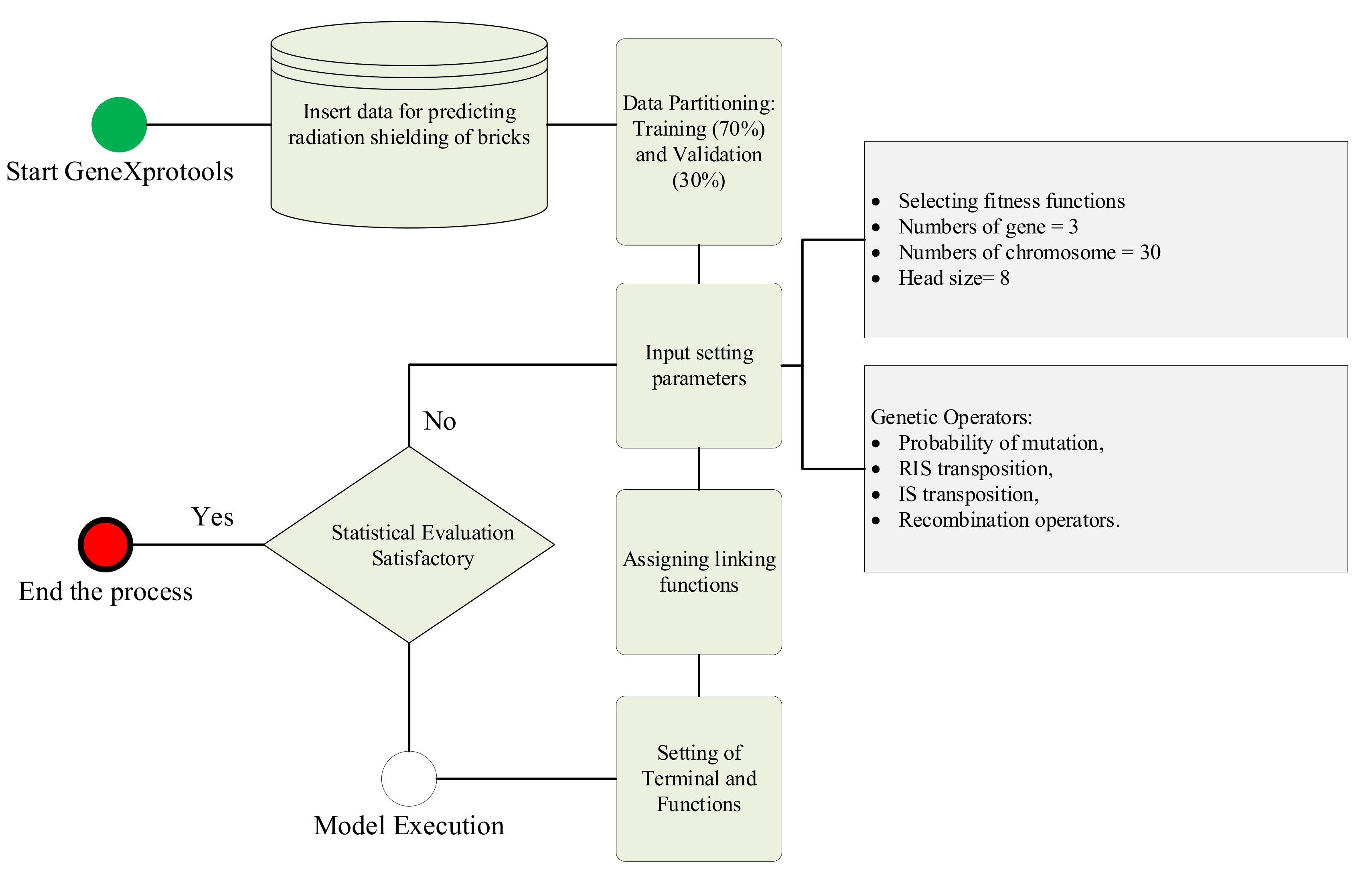
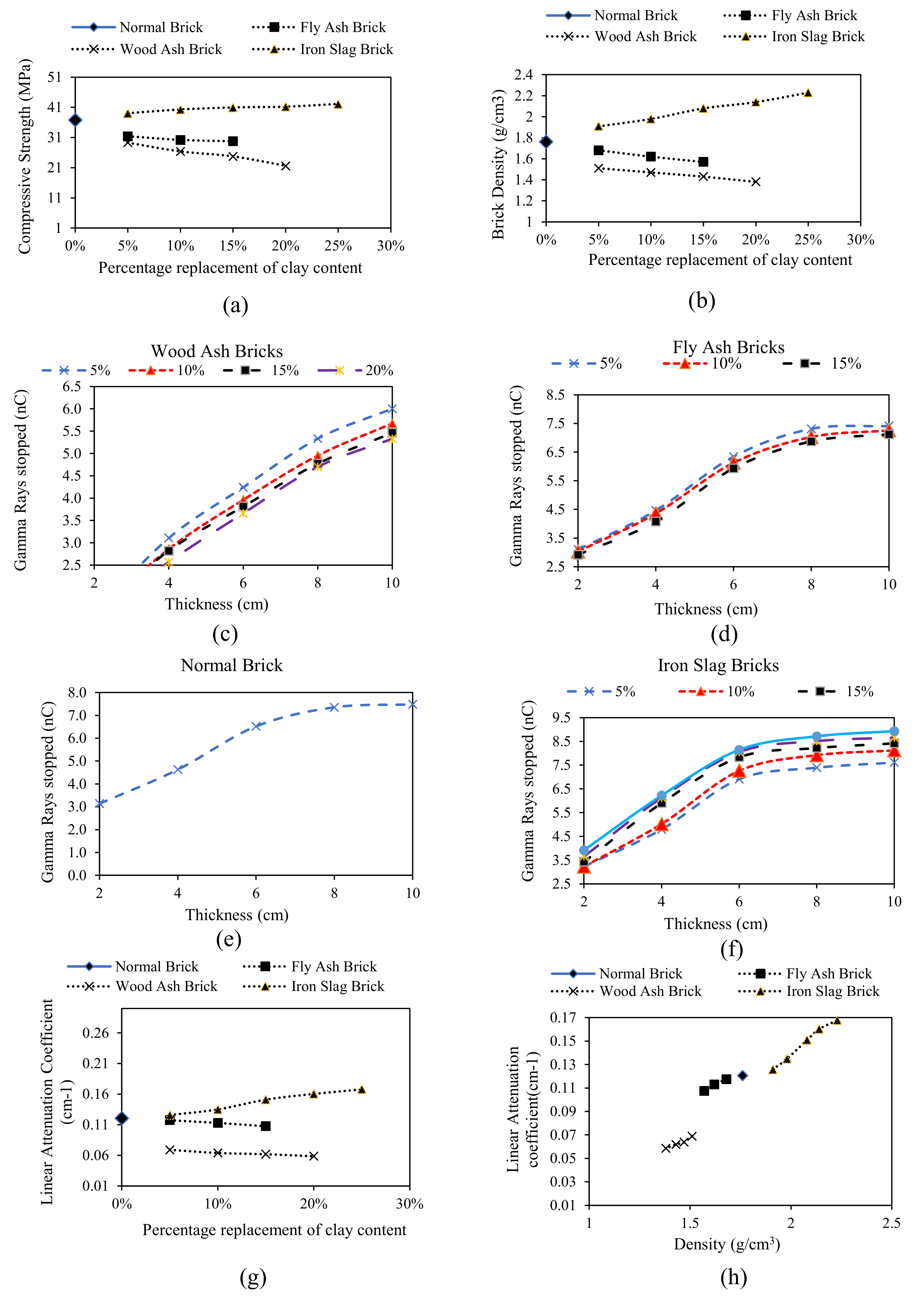
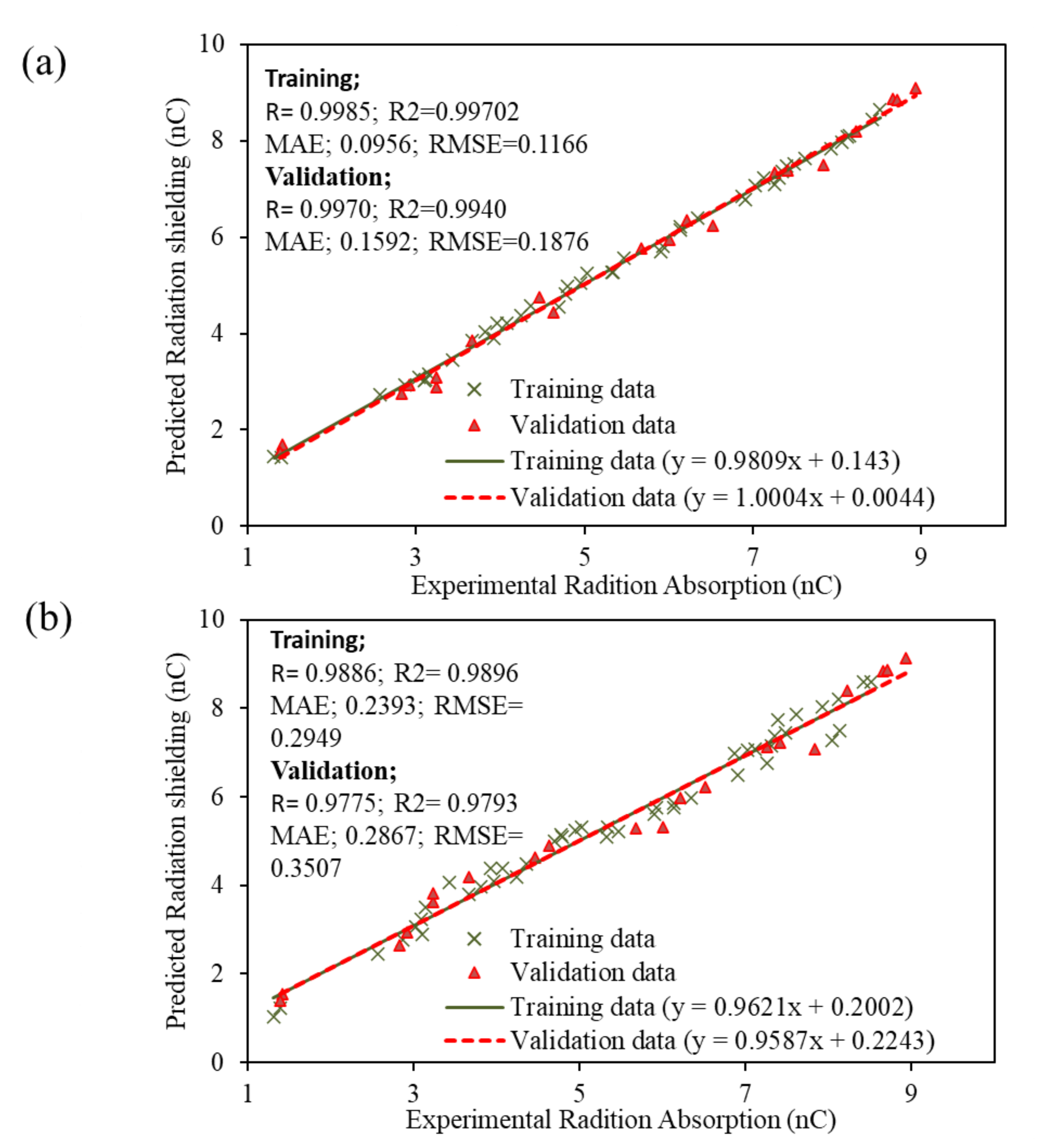
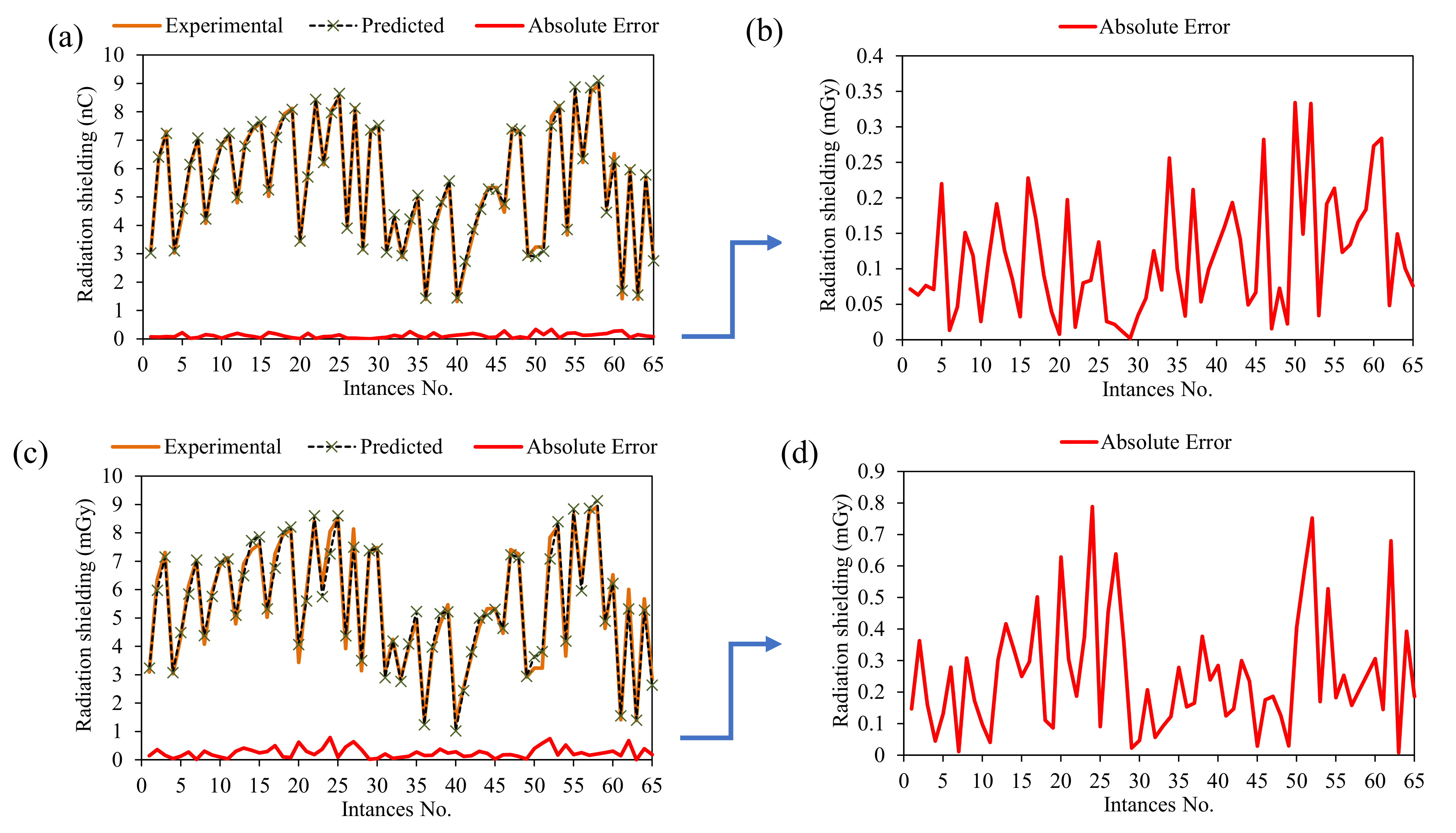
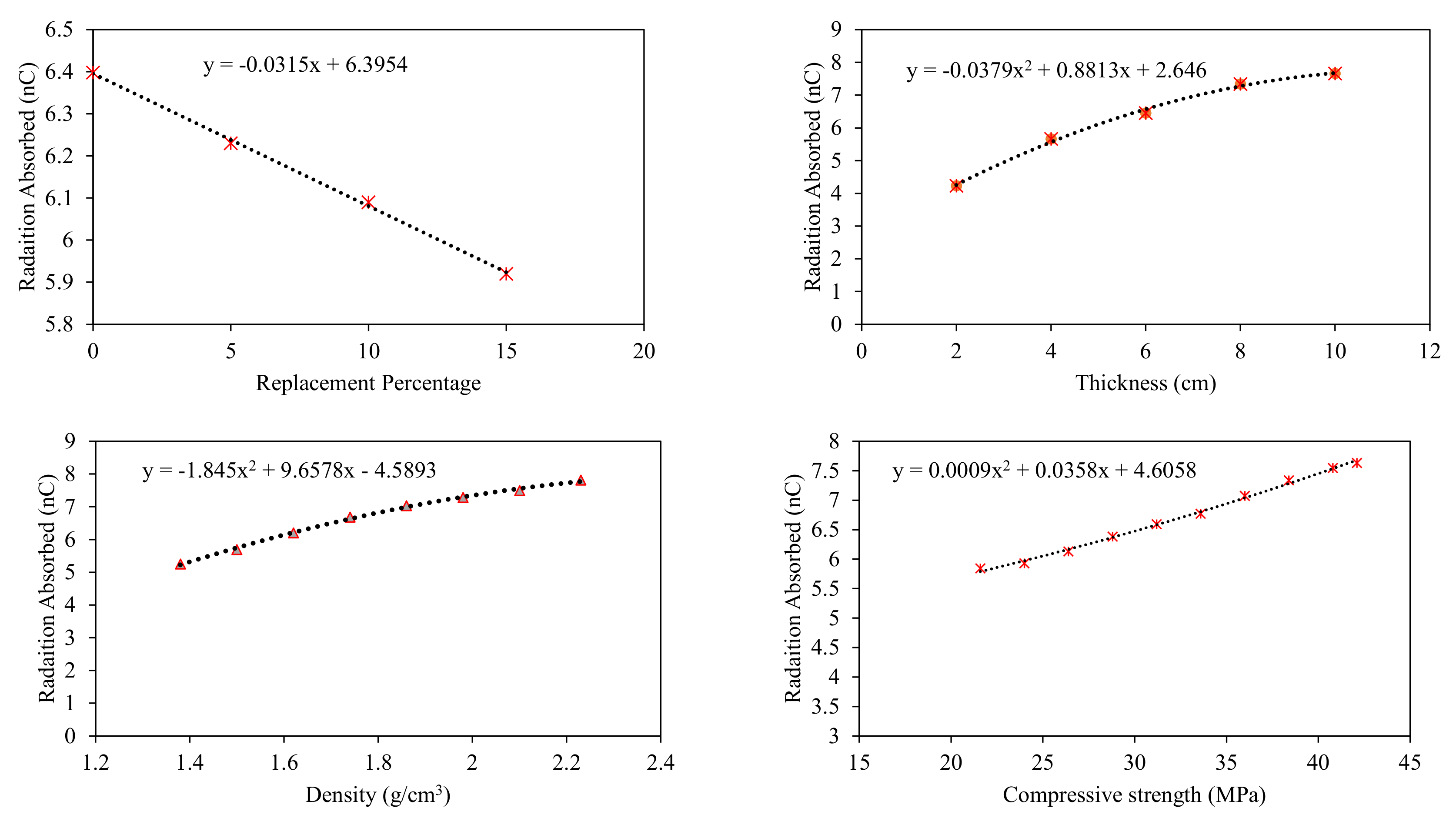
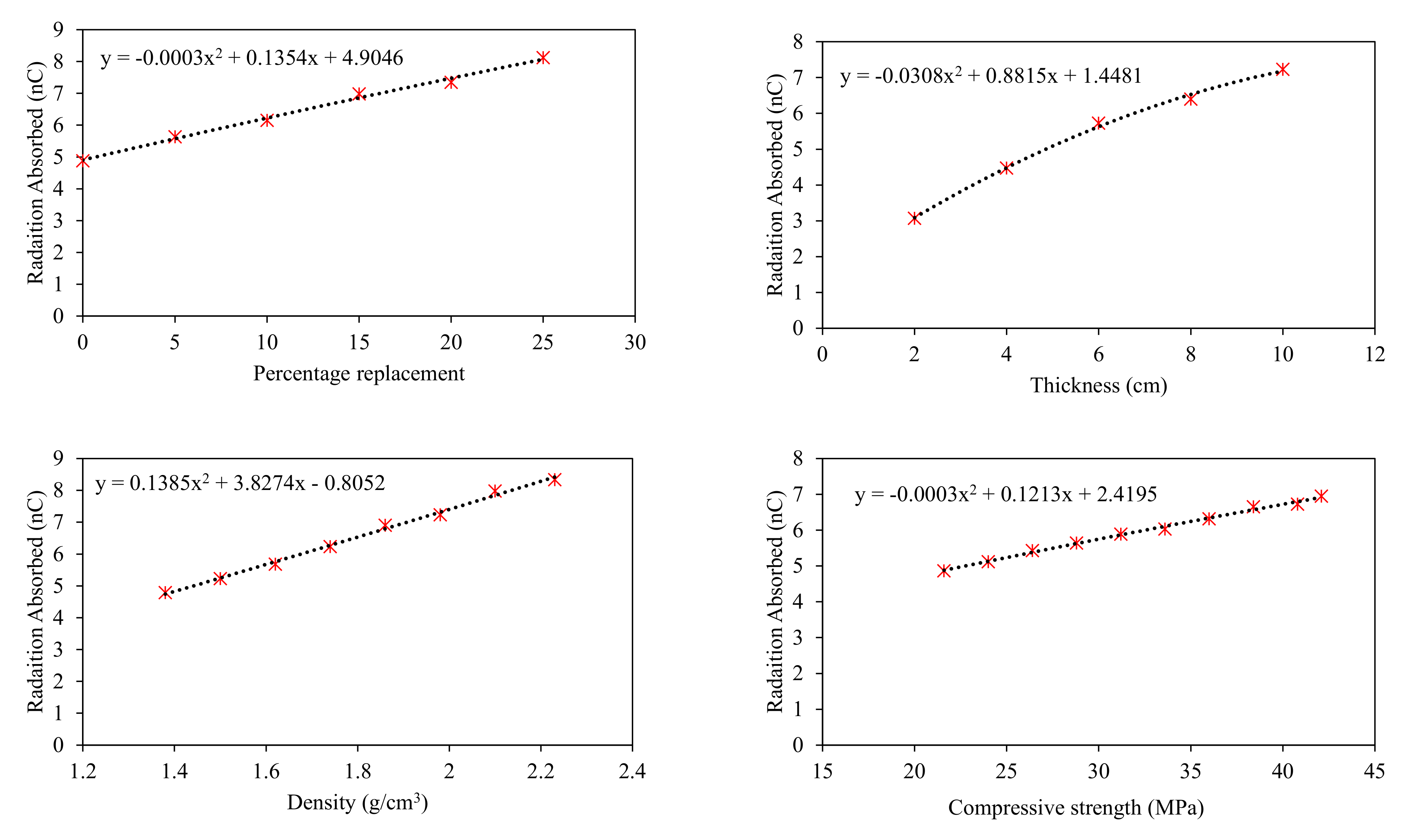
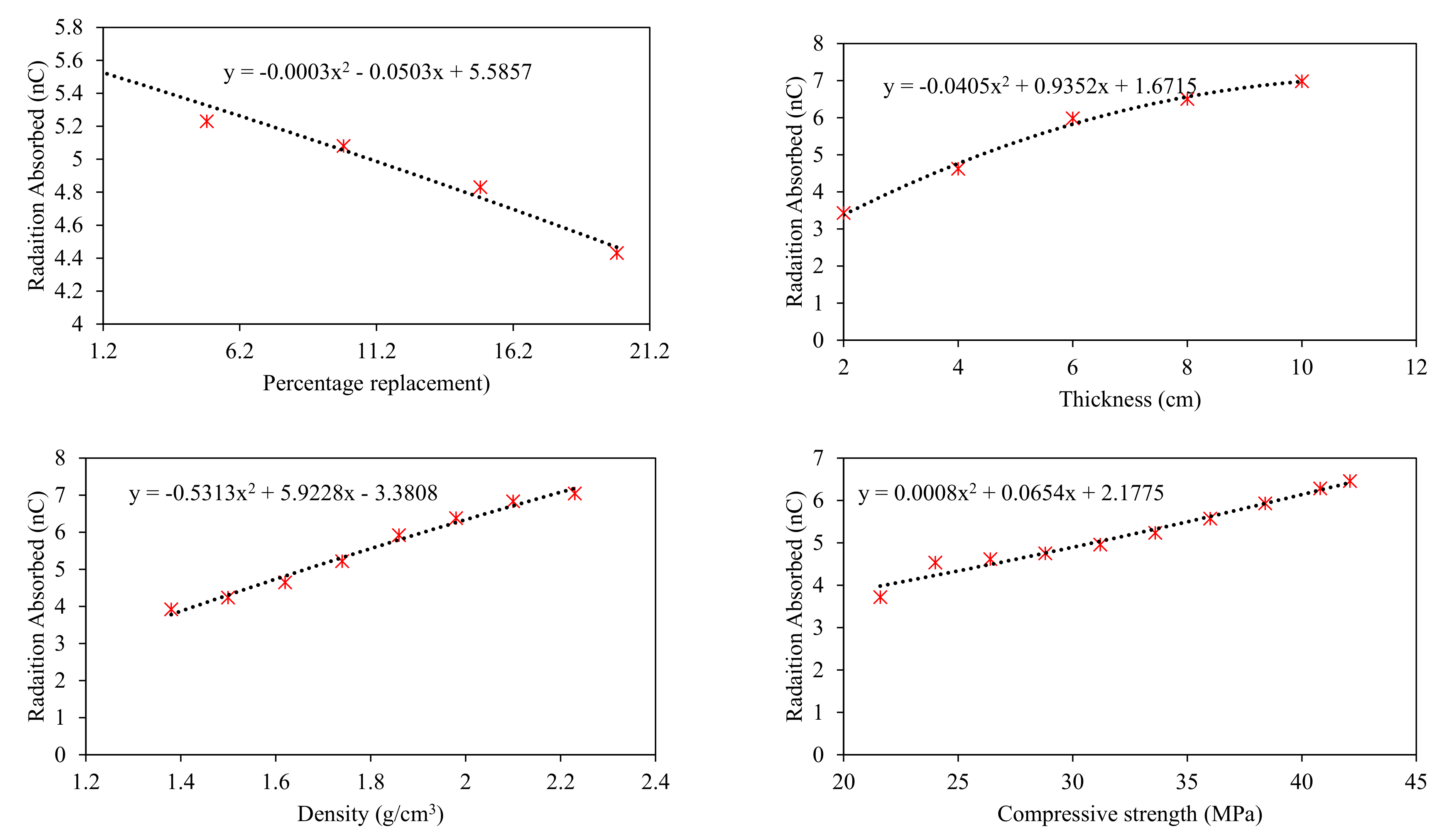
| Reference | Brick Type | Composition | Property Investigated |
|---|---|---|---|
| Mann et al. 2016 [37] | Clay–fly ash brick | Clay partially replaced with fly ash | Radiation shielding of brick |
| Mann, K.S. et al. 2016 [42] | Clay brick | Burnt clay brick collected from local brick factories in Punjab, India | Burnt clay bricks were investigated for surface storage facilities subjected to 0.001–15 MeV gamma ray photon energies |
| Escalera-Velasco, L.A. et al. 2020 [40] | Mexican artisanal bricks | Red clay bricks, yellow bricks, and bricks without cooking | Shielding behavior of artisanal bricks against ionizing photons |
| Kiatwattanacharoen et al. 2020 [43] | Barium sulphate bricks | Clay brick consists of barium sulphate | Clay bricks containing barium sulphate were investigated against X-ray radiation |
| Durak et al. 2022 [36] | Red and yellow clay-based bricks | Red and yellow clay-based bricks containing different amounts of Cobalt metal | Gamma and neutron shielding capacity of the brick |
| Velasco et al. 2022 [44] | Mexican artisanal bricks | Red clay bricks, yellow bricks and bricks without cooking | Radiation shielding parameters of bricks were investigated and compared with NBS concrete |
| Sidhu et al. 2022 [45] | Fly ash–lime–Gypsum (FaLG) | FaLG bricks are unfired compressed bricks consisting of flay ash, lime, and gypum | Shielding behavior of FaLG bricks was investigated |
| S. No. | Brick Type | Material Added | Percentage Addition as a Replacement of Clay |
|---|---|---|---|
| 1 | Conventional Bricks (1) | No additional material | - |
| 2 | Clay–Fly Ash Bricks (2) | Fly ash | 5%, 10%, 15%, |
| 3 | Clay–Wood Ash Bricks (4) | Wood ash | 5%, 10%,15%, 20% |
| 4 | Clay–Iron Slag Brick (3) | Iron Slag | 5%, 10%, 15%, 20%, 25% |
| Material Property | Bulk Density (kg/m3) | Particle Specific Gravity | Color | Water Absorption |
|---|---|---|---|---|
| Clay | 1680 | 2.35 | Dark brown | - |
| Fly ash | 1348 | 1.9 | Black | - |
| Wood ash | 1100 | 1.51 | Light grey | - |
| Iron slag | 2500 | 3.2 | Dark grey | 1.3 |
| Chemical Composition | Clay | Fly Ash | Wood Ash | Iron Slag |
|---|---|---|---|---|
| SiO2 | 57% | 41% | 30.8% | 27.56% |
| Al2O3 | 31% | 22% | 29% | 4.24% |
| Fe2O3 | 7% | 29% | 2.34% | 59.7% |
| MgO | 3.5% | 1% | 8.98% | 1.87% |
| CaO | 1.5% | 2% | 11.23% | - |
| K2O | - | 1.5% | 12.13% | - |
| Na2O | - | 1.81% | 5.50% | - |
| MnO | - | - | - | 2.23% |
| P2O5 | - | - | - | 2.45% |
| SO3 | - | 1.61% | - | 1.90% |
| TiO2 | - | - | - | - |
| Particle Type | Percent Finer | ||||
|---|---|---|---|---|---|
| <20 μm | <50 μm | <75 μm | <100 μm | <150 μm | |
| Clay | 30 | 40 | 45 | 90 | 100 |
| Fly ash | 12 | 56 | - | 86 | 100 |
| Wood ash | 9 | 43 | 66 | 89 | 100 |
| Iron slag | 2 | 15 | 40 | 63 | 90 |
| Input Variables | Output Variable | ||||
|---|---|---|---|---|---|
| Brick Type | Percentage Replacement | Thickness | Density | Compressive Strength | Gamma Ray Absorption |
| (cm) | (g/cm3) | (MPa) | (nC) | ||
| 2 | 5 | 2 | 1.68 | 34.42 | 3.0925 |
| 2 | 5 | 6 | 1.68 | 34.42 | 6.3425 |
| 2 | 5 | 8 | 1.68 | 34.42 | 7.3125 |
| 2 | 10 | 2 | 1.62 | 33.12 | 3.03 |
| 2 | 10 | 4 | 1.62 | 33.12 | 4.36 |
| 2 | 10 | 6 | 1.62 | 33.12 | 6.13 |
| 2 | 10 | 8 | 1.62 | 33.12 | 7.03 |
| 2 | 15 | 4 | 1.57 | 30.79 | 4.0725 |
| 2 | 15 | 6 | 1.57 | 30.79 | 5.9325 |
| 2 | 15 | 8 | 1.57 | 30.79 | 6.8725 |
| 2 | 15 | 10 | 1.57 | 30.79 | 7.1225 |
| 3 | 5 | 4 | 1.91 | 39.03 | 4.7925 |
| 3 | 5 | 6 | 1.91 | 39.03 | 6.9125 |
| 3 | 5 | 8 | 1.91 | 39.03 | 7.3925 |
| 3 | 5 | 10 | 1.91 | 39.03 | 7.6125 |
| 3 | 10 | 4 | 1.98 | 40.27 | 5.0225 |
| 3 | 10 | 6 | 1.98 | 40.27 | 7.2625 |
| 3 | 10 | 8 | 1.98 | 40.27 | 7.9225 |
| 3 | 10 | 10 | 1.98 | 40.27 | 8.1225 |
| 3 | 15 | 2 | 2.08 | 40.94 | 3.4325 |
| 3 | 15 | 4 | 2.08 | 40.94 | 5.9025 |
| 3 | 15 | 10 | 2.08 | 40.94 | 8.4195 |
| 3 | 20 | 4 | 2.14 | 41.2 | 6.13 |
| 3 | 20 | 6 | 2.14 | 41.2 | 8.05 |
| 3 | 20 | 8 | 2.14 | 41.2 | 8.51 |
| 3 | 25 | 2 | 2.23 | 42.1 | 3.92 |
| 3 | 25 | 6 | 2.23 | 42.1 | 8.14 |
| 1 | 0 | 2 | 1.76 | 36.8 | 3.14 |
| 1 | 0 | 8 | 1.76 | 36.8 | 7.35 |
| 1 | 0 | 10 | 1.76 | 36.8 | 7.48 |
| 4 | 5 | 4 | 1.51 | 29.32 | 3.1072 |
| 4 | 5 | 6 | 1.51 | 29.32 | 4.2427 |
| 4 | 10 | 4 | 1.47 | 26.4 | 2.8625 |
| 4 | 10 | 6 | 1.47 | 26.4 | 3.9625 |
| 4 | 10 | 8 | 1.47 | 26.4 | 4.9525 |
| 4 | 15 | 2 | 1.43 | 24.75 | 1.391 |
| 4 | 15 | 6 | 1.43 | 24.75 | 3.8125 |
| 4 | 15 | 8 | 1.43 | 24.75 | 4.7725 |
| 4 | 15 | 10 | 1.43 | 24.75 | 5.4625 |
| 4 | 20 | 2 | 1.38 | 21.6 | 1.31 |
| 4 | 20 | 4 | 1.38 | 21.6 | 2.57 |
| 4 | 20 | 6 | 1.38 | 21.6 | 3.66 |
| 4 | 20 | 8 | 1.38 | 21.6 | 4.7 |
| 4 | 20 | 10 | 1.38 | 21.6 | 5.33 |
| 4 | 5 | 8 | 1.51 | 29.32 | 5.3325 |
| Brick Type | Percentage Replacement | Thickness | Density | Compressive Strength | Gamma Ray Absorption |
|---|---|---|---|---|---|
| (cm) | (g/cm3) | (MPa) | (nC) | ||
| 2 | 5 | 4 | 1.68 | 34.42 | 4.4625 |
| 2 | 5 | 10 | 1.68 | 34.42 | 7.4125 |
| 2 | 10 | 10 | 1.62 | 33.12 | 7.26 |
| 2 | 15 | 2 | 1.57 | 30.79 | 2.9146 |
| 3 | 5 | 2 | 1.91 | 39.03 | 3.2325 |
| 3 | 10 | 2 | 1.98 | 40.27 | 3.2325 |
| 3 | 15 | 6 | 2.08 | 40.94 | 7.8325 |
| 3 | 15 | 8 | 2.08 | 40.94 | 8.2225 |
| 3 | 20 | 2 | 2.14 | 41.2 | 3.66 |
| 3 | 20 | 10 | 2.14 | 41.2 | 8.66 |
| 3 | 25 | 4 | 2.23 | 42.1 | 6.22 |
| 3 | 25 | 8 | 2.23 | 42.1 | 8.71 |
| 3 | 25 | 10 | 2.23 | 42.1 | 8.93 |
| 1 | 0 | 4 | 1.76 | 36.8 | 4.63 |
| 1 | 0 | 6 | 1.76 | 36.8 | 6.52 |
| 4 | 5 | 2 | 1.51 | 29.32 | 1.4111 |
| 4 | 5 | 10 | 1.51 | 29.32 | 6.0025 |
| 4 | 10 | 2 | 1.47 | 26.4 | 1.3895 |
| 4 | 10 | 10 | 1.47 | 26.4 | 5.6725 |
| 4 | 15 | 4 | 1.43 | 24.75 | 2.8225 |
Publisher’s Note: MDPI stays neutral with regard to jurisdictional claims in published maps and institutional affiliations. |
© 2022 by the authors. Licensee MDPI, Basel, Switzerland. This article is an open access article distributed under the terms and conditions of the Creative Commons Attribution (CC BY) license (https://creativecommons.org/licenses/by/4.0/).
Share and Cite
Amin, M.N.; Ahmad, I.; Abbas, A.; Khan, K.; Qadir, M.G.; Iqbal, M.; Abu-Arab, A.M.; Alabdullah, A.A. Estimating Radiation Shielding of Fired Clay Bricks Using ANN and GEP Approaches. Materials 2022, 15, 5908. https://doi.org/10.3390/ma15175908
Amin MN, Ahmad I, Abbas A, Khan K, Qadir MG, Iqbal M, Abu-Arab AM, Alabdullah AA. Estimating Radiation Shielding of Fired Clay Bricks Using ANN and GEP Approaches. Materials. 2022; 15(17):5908. https://doi.org/10.3390/ma15175908
Chicago/Turabian StyleAmin, Muhammad Nasir, Izaz Ahmad, Asim Abbas, Kaffayatullah Khan, Muhammad Ghulam Qadir, Mudassir Iqbal, Abdullah Mohammad Abu-Arab, and Anas Abdulalim Alabdullah. 2022. "Estimating Radiation Shielding of Fired Clay Bricks Using ANN and GEP Approaches" Materials 15, no. 17: 5908. https://doi.org/10.3390/ma15175908
APA StyleAmin, M. N., Ahmad, I., Abbas, A., Khan, K., Qadir, M. G., Iqbal, M., Abu-Arab, A. M., & Alabdullah, A. A. (2022). Estimating Radiation Shielding of Fired Clay Bricks Using ANN and GEP Approaches. Materials, 15(17), 5908. https://doi.org/10.3390/ma15175908







